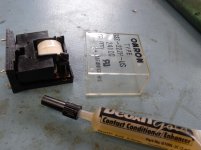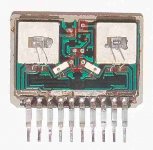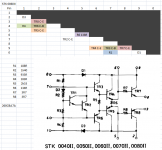Well, I was always wondering about this one since I heard it some 20 years ago.
Then last week by chance found a perfect condition specimen on the local flea market for peanuts, so I decided to give it a chance.
Doing the compulsory homework on a 30 years old amp -replaced all electrolytics in the power stage with Silmic II-s, and Kendeils in the power supply + ultrafast rectifiers- I was totally blown away from what came through on this old piece of hardware....
Having owned, built and listened around 100 different amps (some really good ones too) in the last 30 years, let me tell you, this is a very different animal as far as speed and transparency concerned.
Maybe I am just getting old and losing my marbles, but let me tell you, these guys at Kenwood knew something by then that very few manufacturers are able to repeat today.
The sheer clarity, transparence, and attack of this little amp is breathtaking.
I am hearing information in the upper octaves that sometimes just plain scare me, because they come through with such a realistic way, I often confuse them with environmental noises. Never experienced that with ANY other amp before.
On the attached pictures you can see, that they did their homework on output stage design.... Split feedback for the VAS and current amp stage, critically applied phase correction and speed-up components at all place.
Even that old Darlington power pack does its job in an excellent way, this thing reproduces 40 kHz square waves perfectly, without overshot and ringing.
After all, I am curious about some expert opinions from you, any comments advices, criticism concerning the design?
Then last week by chance found a perfect condition specimen on the local flea market for peanuts, so I decided to give it a chance.
Doing the compulsory homework on a 30 years old amp -replaced all electrolytics in the power stage with Silmic II-s, and Kendeils in the power supply + ultrafast rectifiers- I was totally blown away from what came through on this old piece of hardware....
Having owned, built and listened around 100 different amps (some really good ones too) in the last 30 years, let me tell you, this is a very different animal as far as speed and transparency concerned.
Maybe I am just getting old and losing my marbles, but let me tell you, these guys at Kenwood knew something by then that very few manufacturers are able to repeat today.
The sheer clarity, transparence, and attack of this little amp is breathtaking.
I am hearing information in the upper octaves that sometimes just plain scare me, because they come through with such a realistic way, I often confuse them with environmental noises. Never experienced that with ANY other amp before.
On the attached pictures you can see, that they did their homework on output stage design.... Split feedback for the VAS and current amp stage, critically applied phase correction and speed-up components at all place.
Even that old Darlington power pack does its job in an excellent way, this thing reproduces 40 kHz square waves perfectly, without overshot and ringing.
After all, I am curious about some expert opinions from you, any comments advices, criticism concerning the design?
Attachments
"this thing reproduces 40 kHz square waves perfectly, without overshot and ringing".
A square wave has all harmonics of the frequency produced and they are present on the top leading edge of your wave form and presents itself as ringing. I suspect you are hearing harmonics, which sound satisfying to the human ear. How fast is your oscilloscope?
A square wave has all harmonics of the frequency produced and they are present on the top leading edge of your wave form and presents itself as ringing. I suspect you are hearing harmonics, which sound satisfying to the human ear. How fast is your oscilloscope?
STK 070-III, IIRCEven that old Darlington power pack does its job in an excellent way
You forgot to say: two transfomers, one for each rail ( for keeping the height of the case low ) ; The two caps after the rectifier, I'm still keeping them in another amplifier and they're still fine.
Was the 4558 based tone stage defeatable ?
Yeah, great amp !
The scope is a Leader 1041 dual channel 40MHz scope. Well, the load is an 8 Ohm power resistor, the amplitude is 10v p-p. With a speaker it could be different, but I am not risking feeding my speaker with such a signal.....
The power pack is a STK 0060 II 8A Darlington array, the tone stage is defeatable, (replaced with LM4562 just in case) the input RCA-s feed the power stage through the selector and the defeat switch, with nothing else in the signal path
The power pack is a STK 0060 II 8A Darlington array, the tone stage is defeatable, (replaced with LM4562 just in case) the input RCA-s feed the power stage through the selector and the defeat switch, with nothing else in the signal path
Attachments
Last edited:
Do I see a common-mode bootstrap in the input stage there? Cool.
Unfortunately these amps enjoy a reputation of being notoriously unreliable, mostly due to running hot. Apparently they often had to be run at reduced bias to avoid blowing up (again).
I am still quite fond of the tuner going with this one, the KT-80. The 10µ/16 coupling caps at the output are quiter probably dead at this point though, these should be either bridged or replaced by bipolar / low-leakage types. Very nice-sounding piece of kit after that. Never been that happy with my KT-1100, always sounded thin to me... maybe it needs a recap. I'd just need to do something about the stupid lamp driver circuit, and the wiper contacts in the tuning cap could use some cleaning action again.
Unfortunately these amps enjoy a reputation of being notoriously unreliable, mostly due to running hot. Apparently they often had to be run at reduced bias to avoid blowing up (again).
I am still quite fond of the tuner going with this one, the KT-80. The 10µ/16 coupling caps at the output are quiter probably dead at this point though, these should be either bridged or replaced by bipolar / low-leakage types. Very nice-sounding piece of kit after that. Never been that happy with my KT-1100, always sounded thin to me... maybe it needs a recap. I'd just need to do something about the stupid lamp driver circuit, and the wiper contacts in the tuning cap could use some cleaning action again.
TRIO KA-80
Going through a bit of a TRIO phase at the moment and picked up a spares or repair KA-80 off the bay. It was a bit of a pig to fix, usual blown Darlington power pack but someone had tried to repair before and introduced a solder short elsewhere in the circuit. It was so nice to hear the speaker protection relay kick-in when I finally sussed that one out. As mentioned, these amps run hot because of the high bias and the inverted PCB design so I replaced all the low value caps with high temp versions. While I was at it, I replaced the unreliable filament display bulbs with white LED's - this also helps to reduce the internal heating because you get rid of the high wattage voltage dropper resistors and give more power to the amplifier.
I completely agree. This is a very good amplifier, great bass, very detailed with spine-tingling dynamics. Its just a shame that there are probably so few of them running now that not too many people will get the opportunity to experience.
Going through a bit of a TRIO phase at the moment and picked up a spares or repair KA-80 off the bay. It was a bit of a pig to fix, usual blown Darlington power pack but someone had tried to repair before and introduced a solder short elsewhere in the circuit. It was so nice to hear the speaker protection relay kick-in when I finally sussed that one out. As mentioned, these amps run hot because of the high bias and the inverted PCB design so I replaced all the low value caps with high temp versions. While I was at it, I replaced the unreliable filament display bulbs with white LED's - this also helps to reduce the internal heating because you get rid of the high wattage voltage dropper resistors and give more power to the amplifier.
I completely agree. This is a very good amplifier, great bass, very detailed with spine-tingling dynamics. Its just a shame that there are probably so few of them running now that not too many people will get the opportunity to experience.
Attachments
Aargh! Just when I thought I had the TRIO tamed, it put up a fight. Listening tests revealed the left channel was dropping out to less than half volume setting with annoying regularity. Any number of things could bring it back - tapping the chassis, PCB or a sharp turn on the volume control - classic dry-joint or dirty control/contact issue. I cleaned out the volume pot, no improvement then turned my attention to the speaker protection relay, thinking probably dirty or burned contacts. Its easy to check on the KA-80 because the speaker relay contacts are after the headphone socket and inserting the headphone jack automatically disconnects the speakers - neat! So the next time the channel went quiet, I checked the headphone output and sure enough it was good, balanced stereo. I removed the speaker relay, refurbed the contacts which were dirty, replaced and re-tested. Hurrah, perfect stereo....for about 10 minutes! Running out of options, I had to resort to the carpet-bombing re-solder of all the component leads on the left channel. One of them was obviously dry because now the TRIO is working perfectly again, and sounding much better for its signal path spring clean. I have ordered a replacement relay just in case but it already sounds really stunning, definitely a keeper
Attachments
Great idea about replacing the light bulbs with white LED-s! Now the power transformer gets definitely less warm after a few hours of use. If you have the patience and the necessary parts, it is definitely worth to do the fast rectifier and supply cap replacement mod mentioned in the starting post.. The sound gets even better, cleaner than before.
I used MUR 420 ultrafast diodes, and 10.000 uF/50V Kendeil filter caps in the main power supply, and Elna Silmic II-s in the rest of the circuitry (actually replaced all electrolitycs with those). I admit, the sound is a bit too "analytical" for some tastes, but I have yet to find an other amp with this kind of detail and speed....
I am using it mainly as a testing tool for loudspeaker design, and for that purpose it is just the perfect choice.
I used MUR 420 ultrafast diodes, and 10.000 uF/50V Kendeil filter caps in the main power supply, and Elna Silmic II-s in the rest of the circuitry (actually replaced all electrolitycs with those). I admit, the sound is a bit too "analytical" for some tastes, but I have yet to find an other amp with this kind of detail and speed....
I am using it mainly as a testing tool for loudspeaker design, and for that purpose it is just the perfect choice.
Last edited:
STK0060 II family internal schematic and pic of one I took apart.
I have datasheets and app notes for them. Usually their bonding wires open-circuit (tap it with a plastic pen) or the transistors short.
For the output relay, I use a piece of paper to scrub off oxide on the contacts.
I have datasheets and app notes for them. Usually their bonding wires open-circuit (tap it with a plastic pen) or the transistors short.
For the output relay, I use a piece of paper to scrub off oxide on the contacts.
Attachments
Last edited:
STK0060 II family internal schematic and pic of one I took apart.
I have datasheets and app notes for them. Usually their bonding wires open-circuit (tap it with a plastic pen) or the transistors short.
For the output relay, I use a piece of paper to scrub off oxide on the contacts.
Since you've one already dissected, is there any chance that you could measure the resistance values? That way it could be rebuilt on a similar size PCB.....
Prairiemystic, interesting to find out the design difference between the STK0060 and STK0060 II, quite significant by the look of it. I guess, the unused pins on the STK0060 are not connected so in the KA-80 design, you wont get the benefit of the circuit design. Have you been able to fix faulty modules? How easy is it to remove the cover?
Dragonweed, I will replace the PSU capacitors and rectifier diodes as suggested, more for reliability than sonic benefits but thats welcome too.
Dragonweed, I will replace the PSU capacitors and rectifier diodes as suggested, more for reliability than sonic benefits but thats welcome too.
The only proper way to ensure long term reliability and channel balance is to bite the bullet and blanket resolder the complete amplifier pcb, and then clean with suitable solvent....Running out of options, I had to resort to the carpet-bombing re-solder of all the component leads on the left channel. One of them was obviously dry because now the TRIO is working perfectly again, and sounding much better for its signal path spring clean.
Dan.
Here are the STK datasheets I have, all from the 1980's.
You can test them quite a bit with a multimeter. This saves drama and guess work if the problem is preamp stage/power amp module or both. I don't think you can fix these modules, the transistors usually short or bonding wires break. Surgery is possible but I have not tried it.
Took (pin) measurements on them and surprised to see around 10% tolerance on the resistor values. Carbon-print process must be not so great, or aging.
For these, used old stock from the late 1980's, 10 STK 0080II, and three STK 0060II.
These modules can sound very good, they're a triple EF inside and 0.02% THD was reasonable. I'd like to hear the KA-80 with the JFET front end
You can test them quite a bit with a multimeter. This saves drama and guess work if the problem is preamp stage/power amp module or both. I don't think you can fix these modules, the transistors usually short or bonding wires break. Surgery is possible but I have not tried it.
Took (pin) measurements on them and surprised to see around 10% tolerance on the resistor values. Carbon-print process must be not so great, or aging.
For these, used old stock from the late 1980's, 10 STK 0080II, and three STK 0060II.
These modules can sound very good, they're a triple EF inside and 0.02% THD was reasonable. I'd like to hear the KA-80 with the JFET front end
Attachments
Hello, I am new to repairs, I have a KA-80 amplifier and I intend to repair it because it does not turn on, but first I am going to learn because I do not know much about electronics before trying to repair it, I thank everyone for the information, I realized that it is a good amplifier And what is it worth repairing thanks for the information..
- Home
- Amplifiers
- Solid State
- Blast from the past - Kenwood KA-80
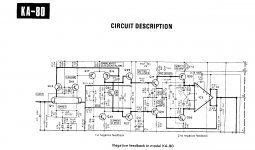
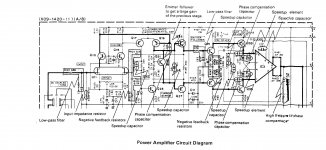
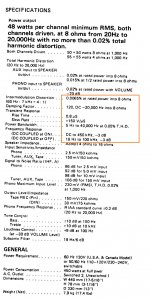
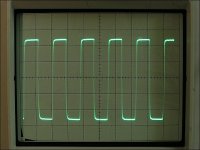
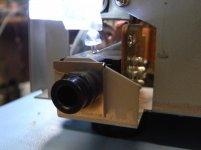
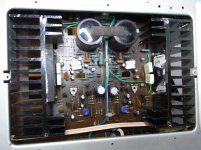
![DSC_0276[1].jpg](/community/data/attachments/560/560094-d04336b2ff7ab04bfefef06fecf5bf8e.jpg)
